When a job-site accident occurs, immediate action is mandatory. Once the individuals involved are taken care of, there are reports to be made, claims to file, cleanup to be done.
But what about near-miss non-accidents? Although there’s no definitive reporting necessary, risk management expert Sean Purcell shares why near-misses are a great opportunity to learn and improve job-site safety.
The value of “almost”
When an accident does occur, the damage (or injury) is done. The root cause isn’t always obvious, so an investigation is conducted to make that determination. But every near-miss serves as an accident gauge, assessing the likelihood of potential danger down the road. It clearly reveals the underlying why because there’s no cleanup or hindsight. If handled correctly, a near-miss can be used to evaluate a scenario, make an adjustment, and prevent a future accident that may cause severe harm—or worse.
It’s not a requirement or standard industry practice for builders to report near-misses. It is, however, recommended that companies create policies to encourage a mindset shift in this direction. It can be as simple as asking the who, what, where, when, why, and how questions typically found on insurance claims and OSHA incident reports. Unless some kind of plan is in place, the value of each near-miss is lost.
Lessons learned
To make the most of near-miss incidents, there are three aspects to consider, each delivering a positive impact to the job-site.
- Education. Employees won’t understand the value of assessing near-misses until the GC or supervisor discusses the topic. It’s vital for employers to encourage near-miss reporting without consequence—emphasizing that workers won’t get into trouble if they talk about their near-misses. It’s about creating an opportunity to learn, not punish.
- Prevention. Near-miss reporting allows for preventative measures to be put into place. A great example of this is ladder placement. If a worker falls off a ladder from one or two feet, an injury is possible, but unlikely. But, if the fall is reported, the team can talk about why it happened, make safety adjustments, and maybe even prevent a death. Near-misses are excellent tools to identify holes and gaps in safety education.
- Morale. The job-site morale implications of near-miss reporting are many. When this policy is in place, employees know they are helping to prevent accidents. And for every accident that is avoided, the ramifications are also avoided. Employees will generally feel safer on the job-site, which tends to make them happier. When lines of communication are open in regard to near-miss reporting, the overall culture of safety is buoyed as well.
Culture shift
The value of near-miss reporting is strongest when it’s ingrained in the company culture. The leadership mentality needs to be, “Hey, thanks for bringing that up! Let’s fix it.” Bigger companies can create a simple reporting form, if desired, but smaller businesses can simply discuss the issue—because it’s a much easier conversation to have before an accident.
One way for site supervisors and GCs to start the shift is by listening to lunchtime banter among employees. When near-miss scenarios are revealed in these light-hearted conversations, it’s an opportunity for immediate intervention. Of course, whenever the safety director is onsite, he or she can stay aware of teachable moments. For example, if a couple of guys are working in a trench without proper trenching safety, the safety director can start a conversation with them. The workers might say, “It would have taken us longer to do the trenching correctly than it would have to finish the job. So, when the trench started coming in, we just dug it out further and kept going.” The safety director can then use this scenario to teach about this near-miss—because it was one—and the importance of trenching safety.
It’s not an overstatement: Near-miss reporting saves lives. Let’s all integrate this important safety measure into the job-site every day. It’s about communicating expectations, re-educating employees, preventing accidents…and, ultimately, strengthening the safety culture.




 Find an
Find an